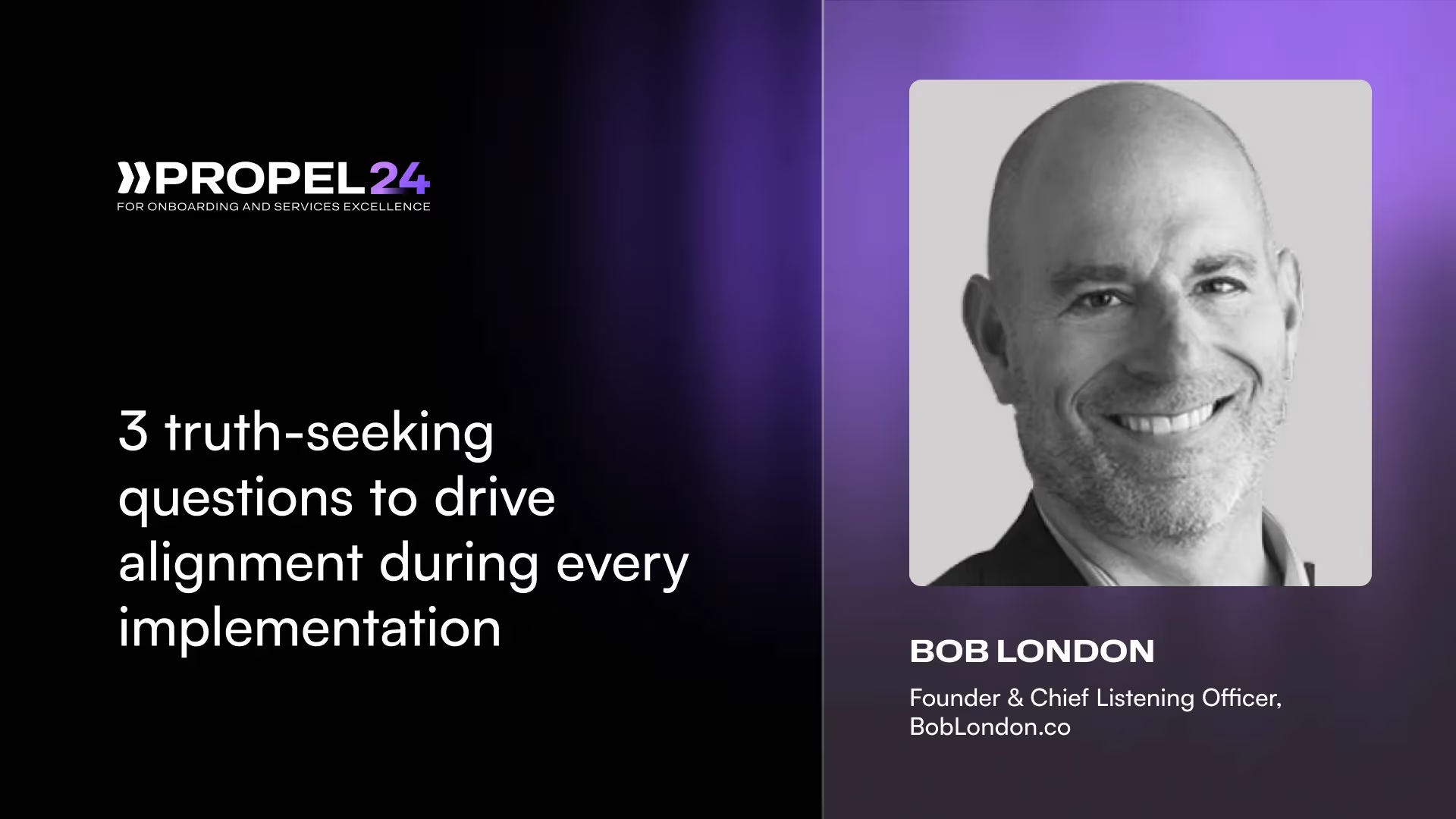The important thing is not to stop questioning. Curiosity has its own reason for existing. - Albert Einstein
Curiosity is not just a trait; it's a powerful tool for customer engagement. It builds trust with customers and reveals insights that can enhance customer retention, successful implementation, and long-term growth.
Two attributes always stand out as crucial yet challenging in customer engagement: discovery and listening. And yet, vendors often struggle to excel in these areas.
Often, the team handling implementation may be disconnected from those who made the economic purchase. The implementation phase is crucial and presents a prime opportunity to reestablish alignment with customers.
At Propel24, Bob London spoke about how curiosity helps in customer engagement and why listening and asking the right questions are important. He shared three truth-seeking questions that drive alignment during every implementation.
The three truth-seeking questions
Questions like "What keeps you up at night?" or "What's your biggest challenge?" are often seen as clichés that fail to engage customers. These queries do not reflect curiosity and tend to put customers on autopilot, leading to generic and uninformative responses such as "We have to do more with less."
Instead of relying on these conventional questions, it's essential to ask truth-seeking questions that engage the customer's mind and make them think. The implementation phase is the perfect time to ask such questions to ensure alignment with the customer's objectives. This period offers a unique opportunity to establish a deeper connection and understanding of their true needs and goals.
A more effective approach involves asking questions that reveal the bigger picture and show a genuine interest in the customer's success.
Q1: If I could sneak into your next board meeting, what is the biggest priority or challenge I would hear them discussing right now?
This type of question aligns the conversation with the customer's broader objectives and opens up a dialogue that can uncover other insights.
By engaging customers with thoughtful, curiosity-driven questions during implementation, vendors can ensure that their services align with the customer's true objectives. This approach fosters trust and establishes a foundation for long-term, successful partnerships.
Effective questioning can transform customer interactions. Simple, targeted questions often prompt detailed responses, revealing crucial insights. It engages customers by making them feel like experts, leading to more open and valuable discussions. For example, a jewelry brand's response about the difficulty of acquiring customers due to new privacy restrictions highlighted its strategic pivot towards opening retail stores to mitigate these challenges.
Aligning the vendor's solutions with these strategic insights creates opportunities for deeper collaboration and growth. Asking follow-up questions about how customers are addressing their challenges further enhances understanding and strengthens the vendor-customer relationship.
Q2: What's the biggest thing that surprised you since you started working with us as a vendor?
While multi-threading within a customer organization is a common strategy, focusing on deepening connections with a single key contact can have profound effects. When done correctly, this approach can make the contact feel valued and unique.
One effective question in this context is, "What has been the biggest surprise since you started working with us?" Initially, this question was designed to uncover negative surprises. However, it often reveals positive surprises as well, highlighting unexpected benefits or aspects of the service.
It's important to ask this question several months into the relationship once the customer has had ample experience with the service. Positive responses can reveal secondary value propositions that were not initially highlighted but are nonetheless significant. For example, a customer might feel exceptionally valued, an unexpected benefit beyond the primary service offering.
Understanding these surprises—whether positive or negative—can provide critical insights into the customer's experience and expectations, allowing for deeper alignment and enhancing the overall relationship.
Q3: If I removed all your tools and resources, which one would you most want back first?
Understanding what a customer deems indispensable is crucial for fostering long-term relationships and driving revenue. This question is designed to identify which tools or resources a customer considers vital, creating a sense of stickiness and value.
Ask this question not just at the beginning but also several months into the relationship. This helps uncover whether your company or another resource holds the highest value and why. For instance, discovering a secondary value proposition—such as making the customer feel exceptionally valued—can provide important insights beyond the primary service offering.
In addition to identifying indispensable tools, asking disruptive, truth-seeking questions can offer deeper insights. For example, asking how a customer would react if contacted by a competitor can reveal their true level of satisfaction. This approach, part of a method called "radically authentic discovery," encourages customers to share genuine feedback, whether positive or negative.
This method of inquiry demonstrates a genuine interest in the customer's needs and experiences. When customers respond with thoughtful answers or mention that they've never been asked such questions before, it shows their appreciation for the authenticity and curiosity in the interaction.
As Maya Angelou said, 'I've learned that people will forget what you said, people will forget what you did, but people will never forget how you made them feel.' By modeling curiosity and transparency, you set the stage for a more authentic and transparent relationship.
Ultimately, the more you ask, the more you grow. That’s the essence of this approach.
{{demo}}














